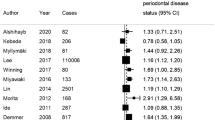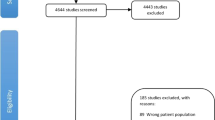Abstract
Data sources The electronic databases PubMed, Embase and the Cochrane Oral Health Group's Trials Register up to 7 July 2020 were searched to identify eligible studies. Information sources in the grey literature were not cited.
Study selection Cohort studies and case-control studies in English were selected by two reviewers independently. All articles had to include a control patient group (without periodontal disease) and a group with periodontal disease and both groups with prostate cancer outcomes. Also, all articles reported the hazard ratio (HR), relative risk (RR) or odds ratio (OR) estimates with their 95% confidence intervals (CIs).
Data extraction and synthesis Data extraction and risk of bias assessments were performed by two reviewers independently and any disagreements between these authors were resolved through discussion or by consulting a third author. Data were synthesised qualitatively by the Newcastle-Ottawa Scale. RR with 95% CI was used as the pooled estimate to assess the association of periodontal disease and the risk of prostate cancer. When the outcome of interest was rare, it was considered that the OR approximated the RR (24). HR was also treated as RR when pooled in this meta-analysis. The heterogeneity across studies was evaluated by Q test (statistical significance was considered when P <0.1) and the I2 statistic (I2 ≥50% indicated significant heterogeneity).
Results Seven studies were included in the meta-analyses, with four being prospective cohort studies and three retrospective cohort studies. All studies were of high quality except one study that was considered to be of moderate quality. Pooled estimates indicated that periodontal disease had a significant statistical relationship with the risk of prostate cancer (RR = 1.17; 95% CI = 1.07-1.27; P = 0.001). No significant heterogeneity across studies was observed (P = 0.383; I2 = 5.8%). The studies include Asian, European and American populations.
Conclusions The authors of this review concluded that periodontal disease could be a possible risk for prostate cancer and that the male public, and clinicians, should be aware of the importance of maintaining good periodontal health.
This is a preview of subscription content, access via your institution
Access options
Subscribe to this journal
Receive 4 print issues and online access
$259.00 per year
only $64.75 per issue
Buy this article
- Purchase on Springer Link
- Instant access to full article PDF
Prices may be subject to local taxes which are calculated during checkout
Similar content being viewed by others
Change history
25 March 2022
A Correction to this paper has been published: https://doi.org/10.1038/s41432-022-0234-2
References
Wei Y, Zhong Y, Wang Y, Huang R. Association between periodontal disease and prostate cancer: a systematic review and meta-analysis. Med Oral Patol Oral Cir Bucal 2021; DOI: 10.4317/medoral.24308.
Caton J G, Armitage G, Berglundh T et al. A new classification scheme for periodontal and peri-implant diseases and conditions - Introduction and key changes from the 1999 classification. J Periodontol 2018; 89 Suppl 1: S1-S8.
Perdana N R, Mochtar C A, Umbas R, Hamid A R. The Risk Factors of Prostate Cancer and Its Prevention: A Literature Review. Acta Med Indones 2016; 48: 228-238.
Stewart L, Moher D, Shekelle P. Why prospective registration of systematic reviews makes sense. Syst Rev 2012; 1: 7.
Walpole S C. Including papers in languages other than English in systematic reviews: important, feasible, yet often omitted. J Clin Epidemiol 2019; 111: 127-134.
Page M J, McKenzie J E, Bossuyt P M et al. The PRISMA 2020 statement: An updated guideline for reporting systematic reviews. Int J Surg 2021; 88: 105906.
Liberati A, Altman D G, Tetzlaff J et al. The PRISMA statement for reporting systematic reviews and meta-analyses of studies that evaluate healthcare interventions: explanation and elaboration. BMJ 2009; DOI: 10.1136/bmj.b2700.
Hartling L, Milne A, Hamm M P et al. Testing the Newcastle Ottawa Scale showed low reliability between individual reviewers. J Clin Epidemiol 2013; 66: 982-993.
Zhang Y, Akl E A, Schünemann H J. Using systematic reviews in guideline development: the GRADE approach. Res Synth Methods 2018; DOI: 10.1002/jrsm.1313.
Guyatt G, Oxman A D, Akl E A et al. GRADE guidelines: 1. Introduction-GRADE evidence profiles and summary of findings tables. J Clin Epidemiol 2011; 64: 383-394.
Guyatt G H, Alonso-Coello P, Schünemann H J et al. Guideline panels should seldom make good practice statements: guidance from the GRADE Working Group. J Clin Epidemiol 2016; 80: 3-7.
Author information
Authors and Affiliations
Corresponding author
Rights and permissions
About this article
Cite this article
Pilati, S., Pilati, P. Does periodontal disease have an association with prostate cancer?. Evid Based Dent 22, 140–142 (2021). https://doi.org/10.1038/s41432-021-0213-z
Received:
Accepted:
Published:
Issue Date:
DOI: https://doi.org/10.1038/s41432-021-0213-z



